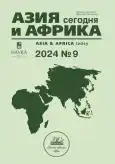The Problem of the Shortage of Fresh Water in Egypt and the Possibilities of Its Solution
- Autores: Volkov S.N1
-
Afiliações:
- Institute for African Studies, Russian Academy of Sciences
- Edição: Nº 9 (2024)
- Páginas: 21-29
- Seção: Politics, economics
- URL: https://journals.rcsi.science/0321-5075/article/view/265311
- DOI: https://doi.org/10.31857/S0321507524090034
- ID: 265311
Citar
Texto integral
Resumo
Palavras-chave
Sobre autores
S. Volkov
Institute for African Studies, Russian Academy of Sciences
Email: sergey.n.volkov@outlook.com
ORCID ID: 0000-0002-6152-1091
PhD (Economics), Associate Professor, Head Moscow, Russia
Bibliografia
- Rashida M.R. 2013. Barakat. Epidemiology of Schistosomiasis in Egypt: Travel through Time: Review. Journal of Advanced Research. № 4(5). Pp. 425–432. doi: 10.1016/j.jare.2012.07.003. https://www.ncbi.nlm.nih.gov/pmc/articles/PMC4293883/ (accessed 25.06.2024)
- Kuzma S., Saccoccia L., Chertock M. 25 countries, housing one-quarter of the population, dace extremely high water stress. World Resources Institute. https://www.wri.org/insights/highest-water-stressed-countries (accessed 25.06.2024)
- Progress on the level of water stress. Indicator 6.4.2 of the SDGs at the global level and the need to accelerate progress towards its achievement in 2021. FAO and UN-Water Resources. Rome, 2023. doi: 10.4060/cb6241ru
- Abdel-Shafy H.I., Aly R.O. 2002. Water Issue in Egypt: Resources, Pollution and Protection Endeavors. Central European Journal of Occupational and Environmental Medicine. Vol. 8. № 1. Pр. 3–21. https://www.researchgate.net/publication/299579941_Water_issue_in_Egypt_Resources_pollution_and_protection_endeavors (accessed 25.06.2024)
- Ezzeldine M. 2021. Water resources management in Egypt: problems and solutions. Construction: Science and Education. Vol. 11, № Pp. 1–14. doi: 10.22227/2305-5502.2021.1.1
- El Deen S.M. 2022. Egypt’s water policy after the construction of the Grand Ethiopian Renaissance Dam. Arab Reform Initiative. https://www.arab-reform.net/publication/egypts-water-policy-after-the-construction-of-the-grandethiopian-renaissance-dam/ (accessed 25.06.2024)
- Gado T.A., El-Agha D.E. 2021. Climate Change Impacts on Water Balance in Egypt and Opportunities for Adaptations. In: Abu-hashim M., Khebour Allouche F., Negm A. (eds). Agro-Environmental Sustainability in MENA Regions. Springer Water. Springer Cham. doi: 10.1007/978-3-030-78574-1_2
- Agreement on the Nile River Basin Cooperative Framework. Nile Basin Initiative. https://nilebasin.org/sites/default/files/attachments/CFA%20-%20English%20FrenchVersion.pdf (accessed 25.06.2024)
Arquivos suplementares










